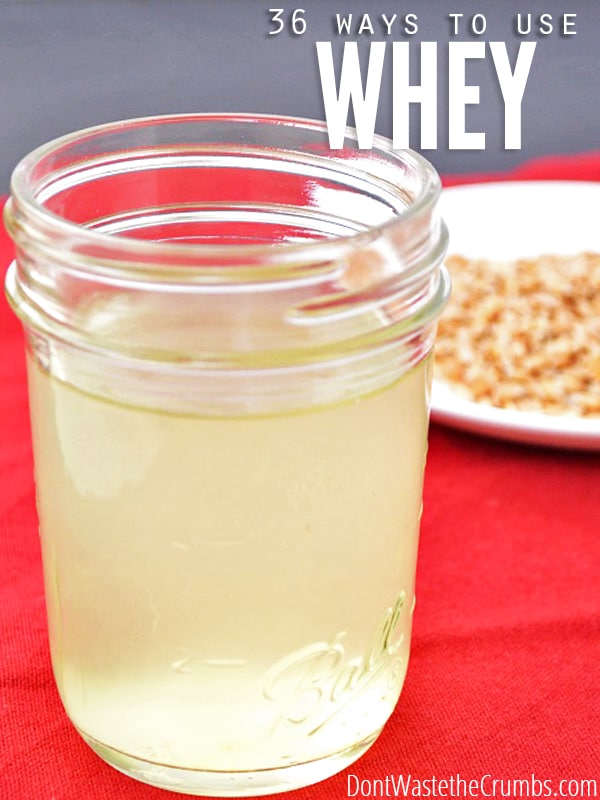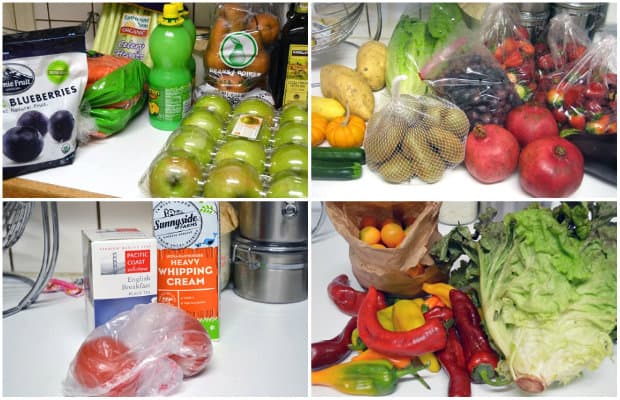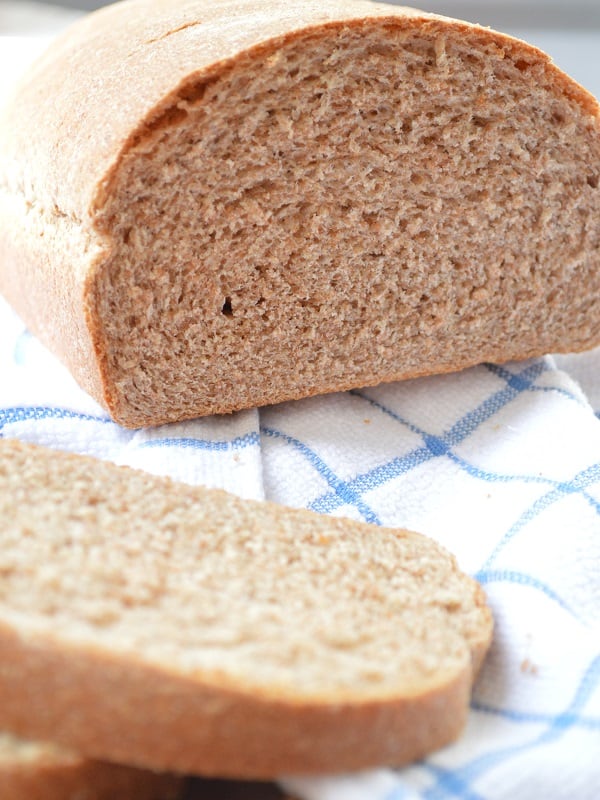
My daughter has this Minnie Mouse seek-and-find book that she can’t seem to put down. She’s found everything on every page, several times over, but still likes to look at all the pictures.
I like kefir just as much, and since there’s always a jar culturing on my kitchen counter, it often finds its way into my budget accountability posts.
I thought it would be fun to do a little seek-and-find with my kefir jar. Because who couldn’t use a little game on Hump Day? Can you find the kefir in these pictures?

Black bean brownie points if you found all four.
So, back to the kefir. Is it mere coincidence that the easiest fermentation in the whole wide world is also likely the healthiest? I think not.
In case you didn’t know how easy it was, allow me to share quick tutorial:
- combine kefir grains with milk
- allow to sit on the counter for 12-36 hours
- strain grains and repeat
See? Easy peasy.
But one day I let my kefir sit too long and it started to do something weird… the white separated from everything else and I seriously thought I was making cheese.
Which is a whole ‘nuther story. But anyway.
As it turns out, that weird yellow-ish liquid is whey. I’m sure you’ve seen the same weird liquid surface in yogurt and sour cream after a few days. In my pre-real food days, I would have poured off this weird looking stuff and asked Mr. Crumbs if my yogurt was still okay to eat.
As if either of us really knew.
Nowadays though, I’m pouring off this healthy liquid and saving it for something useful like soaking my oats or making pancakes or using it place of water in other recipes.
Did you know that whey contains calcium, thiamin, vitamin B12, vitamin B5, magnesium, potassium, riboflavin, phosphorus, selenium and zinc? Plus loads of other nutrients. Not too shabby for what we originally thought was just icky weird gross stuff!
5 Ways to Make Whey
First, there are two types of whey: sweet whey and acid whey.
Sweet whey is the liquid that comes from making cheese with rennet, like cheddar or Swiss.
Acid whey is the by-product of cultured dairy products like sour cream or yogurt.
Both types of whey are super rich in protein, vitamins and minerals, so we want to find ways to use them up instead of pouring them down the drain. However, acid whey can be damaging to the environment in large quantities, so it’s best to just use sweet whey for gardening and composting ideas.
Although whey will occur naturally without your doing anything, if you DID want to make whey, here are five ways you can do it:
- Allow raw milk to sit at room temperature where the natural bacteria will cause the milk to clabber. Strain the milk using a cheesecloth, a tea towel or an old (but clean) thin t-shirt.
- Use a fine mesh strainer, clean towel or cheesecloth to strain cultured yogurt.
- Strain cultured kefir (with the same methods as #2).
- Strain cultured buttermilk (with the same methods as #2).
- Make homemade Greek yogurt (which is essentially the same as #2).
Why Should You Make Whey?
Two big reasons:
#1 – It’s healthy. Please refer to the above list of 10 vitamins and minerals for details.
#2 – It’s cheap. Like, WAY cheap! As in, it doesn’t cost a dime!
There’s an assumption that if you’re making whey, your original goal was to make something else instead. Whether that be yogurt or kefir or cheese – you were making something other than whey. Therefore, the whey is like a bonus food and free.
There’s a big list below of things you can do with whey, but here’s the best part: When you use whey, you’re replacing something else that cost money. That could be lemon juice, vinegar, milk or even just plain water. When you use whey instead, you’re saving money.
In summary, whey = free healthy food. Awesome! Curious what amazing uses this super-frugal-healthy food has?

36 Ways to Use Whey
- Culture foods. Using the methods in Nourishing Traditions, you can use whey to ferment all sorts of foods… beets, cabbage, carrots – you name it!
- Soak grains. We soak our oatmeal and weekly batches of bread, and now we’ll be doing it with whey. It costs me money to make those (or buy lemon juice), and whey is free!
- Soak beans. Just like grains, your digestive system benefits from beans being soaked before cooking. Swap your acid medium and use whey, or feel free to add more!
- Soak nuts. For the same reasons above. (More on soaking.)
- Make pizza dough. Add a sourdough-ish tang to your dough for a delicious pie. Here’s our favorite dough recipe.
- Make bread. My latest batch of soaked bread (above) was made with 100% whey as the liquid and it was SO good! I’ve heard it helps with whole grains and creating a better texture and my taste buds confirmed this one!
- Stick it in smoothies. Whey is naturally high in protein (almost 2g in one cup!) and it’s my first choice for extra liquid when making protein smoothies.
- Condition your face. The cultures in whey are acidic, so toss some on a cotton ball and use it as a toner.
- Condition your body. Up the ante and add one cup of whey to your bath for an all-over-the-body skin toner.
- Make a face mask. Use whey combined with soothing raw honey for an easy face mask. Your skin will be loving you! More details here.
- Condition hair. If you’re washing with baking soda, a diluted whey rinse will work just as well as the diluted vinegar rinse!
- Pet food. Instead of throwing the extra nutrients down the drain, add them to pet food for some extra vitamins!
- Dog treats. Get the recipe!
- Water the plants. Speaking of saving on water, add a bit of this to your watering can. Be sure to use sweet whey though and not acid whey since it might damage the nutrients in the soil so you should definitely dilute it first. Check out this article for more information.
- Balance the garden’s pH. If watering the plants is out of the question, consider balancing the pH levels of peas, cucumbers and squash by spraying some on just the leaves – the whey will kill the mold that grows! (Again, sweet whey only.)
- Lower the garden’s pH. Blueberries, roses and tomatoes like acidic soil and whey will help you achieve just that.
- Add it to compost. A great outdoors spot if you don’t feel comfortable adding it to your garden, or don’t have one to add it to!
- Substitute for buttermilk. Biscuits, dressings or pancakes? Yep, use whey!
- Substitute for milk. Instead of milk, use whey to make creamy cheese sauce that will get baked and cheese-ified.
- Make rice. Although the heat will kill some of the live enzymes, you’ll still retain the nutrients since rice absorbs all the liquid.
- Make risotto. A combination between the previous two, you’re cooking rice and making it creamy at the same time. Might as well add some nutrition too!
- Make chicken stock. Substitute not just for the apple cider vinegar, but for some of the water too! Trade up to half of the water (or more, depending on your taste preference) for whey and come out the other side with a richer, more flavorful stock.
- Thicken gravy. Chances are if you’re making gravy, it’s topping something unhealthy. Boost the nutrition by using whey.
- Substitute for orange juice. Whey is about as acidic as orange juice, so if you’re using the juice in smoothies or in baking (like yummy scones or in a quick bread), try swapping for whey instead.
- Substitute for lemon juice. Whey tastes much like lemon juice, so it makes a great substitution in recipes or cocktails…
- Make a cocktail. Half whey and half juice, plus sweeten to taste with honey or stevia and you’ve got yourself a deliciously healthy drink!
- Use in salad dressing. Instead of a vinaigrette with lemon juice, how about a vinaigrette with whey?
- Tenderize meat. Swap whey for any vinegar in a traditional meat marinade. Mind that whey will add tang, so adjust seasonings accordingly.
- Make lemonade. Seriously. Here’s the recipe.
- Make ginger ale. Yum!
- Make cream cheese. Similar to the method of culturing milk with buttermilk, but you’re culturing milk with whey and straining for cheese. More details here.
- Make soda. Again, seriously! There’s a Swiss drink called Rivella that’s 10% whey. Way cool!
- Make caramel. Add a bit of salt with a touch of sugar and voila – instant caramel!
- Use it as a brine. Feta cheese will keep longer in whey, and you can use it when brining your Turkey in November too!
- Make ricotta cheese. The word “ricotta” means cooked twice, which is what ends up happening to the whey when you make this cheese. Here’s a super easy tutorial that even I, the bad-cheese maker, could likely do right!
- When all else fails – freeze it. If you’ve got too much and you’re unsure what to do with it, freeze it in ice cubes for later!
- Bonus idea – make mayo. Whey will kick your homemade mayo up a notch by lacto-fermenting it. It also allows the mayo to last longer!
But wait – there’s more! The above ideas were spawned after too much web surfing and not enough dinner. Both Salad in a Jar and The Prairie Homestead have a few more unique ideas for using whey, just in case the above 36 weren’t enough for you.
Whey is the frugal foodie’s super-liquid. What’s your favorite way to use it?
Some Other Posts You Might Like:
Original article and pictures take dontwastethecrumbs.com site



Комментариев нет:
Отправить комментарий